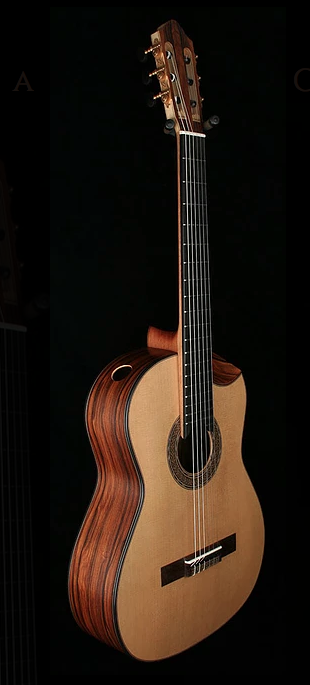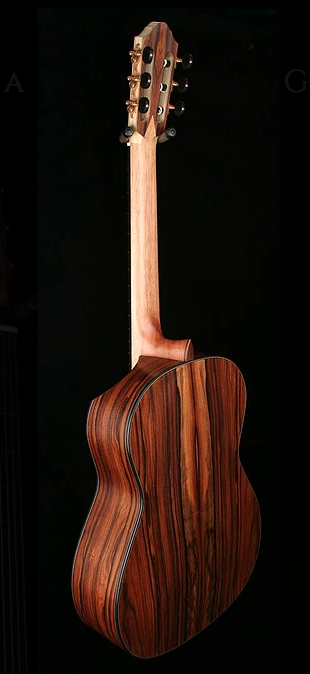Bellucci guitar with an ‘Indented Cutaway’ from Mangore guitars.
Introduction
Access to frets past the 12th fret has gained increasing attention from luthiers and guitarists for at least a decade. I mentioned in Part 1 of my series on modern classical guitar design that an ‘indented cutaway’ is a somewhat modern design feature that a few luthiers are starting to incorporate into their designs.
Standard Cutaway vs Indented Cutaway
Here are two of my own guitars showing two of the most common types of cutaway. The guitars are Takamine TNV460SC on the left and a Takamine TH5C on the right. I have two video reviews of both of these guitars that you can watch farther on in this article.
Here is a full review of my Takamine TH5C Hirade model.
The Indented Cutaway
With an indented cutaway only a small section of the soundboard, back & sides is removed. The fundamental idea is that the overall sound and projection of the guitar isn’t compromised but access to the higher frets is improved. This is best shown by a picture.
One of Kris Barnett’s stunning guitars featuring an indented cutaway.
As you can see the smaller cutaway leaves a significant amount of the guitars’ chamber undisturbed.
Pros
- Improves access to upper frets
- Visually striking
- Has an unusual and modern look
Cons
- Has an effect on the power on tone of the instrument
- Probably not as effective as a raised fretboard
- Clearly visible departure from a standard classical guitar design
- Niche design therefore it could be difficult to resell
The same Kris Barnett guitar when viewed from the rear. As you can see the indented cutaway removed minimal wood from the guitar.
My Verdict
I’d love to try one. Sadly, I haven’t had the opportunity to play a guitar with an indented cutaway for two reasons:
- Very few luthiers actually make this design
- Those that do are expensive and usually have extremely long waiting lists
I think it could be a really great feature to have on your guitar but I think I’d probably choose an elevated fretboard rather than this particularly for resale purposes.
So…where can I buy one?
Here are two luthiers that make these guitars:
Check out my other articles in the
‘Modern Classical Guitar Design Series’:
Part 8: Fanned Frets
Part 7: Arched back
Part 6: Double Tops
Part 5: Lattice Bracing
Part 4: Armrest
Part 3: Soundports
Part 1: Elevated Fingerboard



